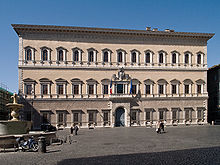Embassy (diplomacy)
An embassy is a diplomatic representation of one state at the seat of government of another state. Other diplomatic representations in addition to embassies are permanent representations , embassies , nunciatures and high commissioners. The consular representations are to be distinguished from diplomatic representations .
Mission of the embassy
The ambassador's task is to represent his state in relation to the host country, to report on the situation of the host country to his government, and to maintain and develop international relations with the host country's institutions as far as possible.
The diplomatic mission can also be entrusted with the performance of consular tasks (e.g. issuing visas for foreigners and issuing passports for their own citizens ).
Structure and type of a message


An embassy consists of the office and the residence. The office is the administration and, like every authority, is subdivided into different departments. The residence is the residence of the ambassador and his family. It also serves as the official representation at business receptions on various occasions and is usually housed in the same building with the office for small embassies, but in a separate building for large embassies and often in another part of the city.
The law firm usually consists of the political department and other specialist departments, such as B. the trade department, military department, cultural department or press department. If consular tasks are also performed by the embassy, there is also a consular section. As a rule, the embassy only performs consular functions for part of the national territory of the host country. For the remaining part, it is supported by other consulates ( consulate general , vice consulates and honorary consulates ) in other cities in the host country.
Germany
The Foreign Service of the Federal Republic of Germany consists of the Foreign Office and the missions abroad (diplomatic and consular), which together form a single highest federal authority under the direction of the Federal Minister for Foreign Affairs . Since the Schülerer reforms of 1918/1919 there has been a uniform career path for diplomats and career consul officials. The political department and the consular department in particular are staffed by foreign service officials. In other embassy departments (trade, military ) officials and soldiers from line ministries or other authorities are sent to the embassies for a certain period of time. During the posting period, the officials receive diplomatic status and are officially subordinate to the Foreign Office. Germany currently has 153 embassies that are responsible for maintaining diplomatic and consular relations with 195 countries.
In addition to permanent missions maintained at between national and supranational organizations. Particularly important permanent representations have been set up at the European Union , NATO and the United Nations . There was also a permanent mission for relations with the GDR .
Switzerland
In Switzerland, the diplomatic services are taken over by the Federal Department of Foreign Affairs (FDFA) in Bern . The Swiss Confederation maintains a network of over 100 embassies worldwide. The Federal Office for Buildings and Logistics (FOBL) is responsible for the federal properties. In the history of Switzerland, the so-called good offices are of particular importance. Due to its neutrality, Switzerland can act as a mediator between various conflicting parties from (hostile) states.
Austria
The diplomatic service for Austria is provided domestically by the Federal Ministry for Europe, Integration and Foreign Affairs and abroad by the Austrian representation authorities . Admission to the higher external service takes place after successfully completing a legally prescribed, multi-stage selection process ("A-Préalable"), usually after training at the Diplomatic Academy of Vienna .
Vatican
The task of the diplomatic missions of the Holy See (i.e. the Pope as subject of international law ), which also represent the interests of the Vatican City State , is carried out by the Apostolic Nunciatures . In many countries the nuncio acts as the doyen of the diplomatic corps .
European Union
The European Union (EU) has 130 diplomatic missions abroad, known as delegations . The EU delegations perform a similar function as embassies for national states to the European Union.
Commonwealth
Another specialty is the mutual diplomatic missions of the states of the Commonwealth of Nations . These bear the title of High Commissions (High Commission). This is due to the fact that the British monarch is also the head of state of all Commonwealth Realms . The diplomatic heads of these missions - High Commissioners - ( High Commissioner ) are therefore formally appointed by their respective governments. The republics (e.g. India, Trinidad and Tobago) and other monarchies (e.g. Malaysia, Brunei) in the Commonwealth of Nations also practice the practice of not exchanging ambassadors. Ambassadors are exchanged with non-Commonwealth countries.
historical development
After the Congress of Vienna , the five great powers of the 19th century, France , Great Britain , Austria , Prussia and Russia , set up embassies in the capitals of the other great powers. The diplomatic representations of the smaller states as well as the representations of the great powers in smaller states, however, were referred to as embassies .
With the upgrading of a legation to an embassy, the increased power position of a state was also recognized diplomatically. In 1906, for example, the Japanese embassy in Germany and the German embassy in Tokyo were elevated to the status of embassy. By 1914, the German legations in Italy , Spain , Turkey and the USA were also converted into embassies.
In the 1950s and 1960s, most of the previous legations were upgraded to embassies, so that nowadays all embassies from all countries have the same protocol status. Note, however, the institute of the permanent representation , which is separated from the term "embassy".
Embassy building

The area on which an embassy is located is under special international law protection ( Vienna Convention on Diplomatic Relations , Article 22), so that the host country may not enter, search, confiscate or make arrests without the consent of the Head of Mission. Although the embassy premises are not extraterritorial , the embassy and its diplomats enjoy diplomatic protection and diplomatic privileges.
For more information on the legal status of the mission building see → main article diplomatic status .
The protective rights applicable to embassies are occasionally exploited by citizens who are denied entry to the embassy country. In 1989 the German embassies in Budapest , Warsaw and Prague played a very important role in German history . In September, the Hungarian government was the first to allow GDR citizens who had fled to the grounds of the West German embassy to leave for the West. A few weeks later, in September 1989 , Hans-Dietrich Genscher was able to announce to hundreds of refugees who were waiting in the German embassy in Prague that their departure had been allowed. In the years before, there were occasional embassies in Warsaw and East Berlin ( permanent representation ), which were mostly handled discreetly. 2003 occurred in China's capital Beijing several times escapes from North Koreans who were in China for a visit and so most successfully, about the messages (also German ) to South Korea escaped.
Between 2000 and 2011, Berlin offered the “ All Nations Festival ” the opportunity to view several embassies from the inside.
See also
Web links
Germany:
- Websites of German diplomatic missions abroad
- Embassies in Germany
- Law on the Foreign Service (PDF; 27 kB)
- Embassies (definition of the Federal Foreign Office)
Austria:
Switzerland:
United States:
Individual evidence
- ↑ Foreign Office: Embassies. October 23, 2013, accessed January 22, 2016 .
- ↑ Representations and travel advice. Retrieved April 14, 2019 .
- ↑ Good offices. Retrieved April 14, 2019 .
- ↑ https://www.bmeia.gv.at/das-ministerium/karrieremoegitäten/laufbahn-im-bmeia/hoeherer-auswaertiger-dienst/%7C page of the Austrian Foreign Ministry
